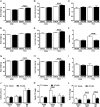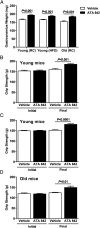Anti-myostatin antibody increases muscle mass and strength and improves insulin sensitivity in old mice
- PMID: 26858428
- PMCID: PMC4776508
- DOI: 10.1073/pnas.1525795113
Anti-myostatin antibody increases muscle mass and strength and improves insulin sensitivity in old mice
Abstract
Sarcopenia, or skeletal muscle atrophy, is a debilitating comorbidity of many physiological and pathophysiological processes, including normal aging. There are no approved therapies for sarcopenia, but the antihypertrophic myokine myostatin is a potential therapeutic target. Here, we show that treatment of young and old mice with an anti-myostatin antibody (ATA 842) for 4 wk increased muscle mass and muscle strength in both groups. Furthermore, ATA 842 treatment also increased insulin-stimulated whole body glucose metabolism in old mice, which could be attributed to increased insulin-stimulated skeletal muscle glucose uptake as measured by a hyperinsulinemic-euglycemic clamp. Taken together, these studies provide support for pharmacological inhibition of myostatin as a potential therapeutic approach for age-related sarcopenia and metabolic disease.
Keywords: aging; insulin resistance; muscle mass; myostatin; sarcopenia.
Conflict of interest statement
Conflict of interest statement: These studies were funded in part by an investigator initiated grant to K.F.P. from Atara Biotherapeutics, the manufacturer of ATA 842. G.F. and C.M.H. are employees of Atara and may own stock in the company.
Figures




Similar articles
-
Myostatin and sarcopenia: opportunities and challenges - a mini-review.Gerontology. 2014;60(4):289-93. doi: 10.1159/000356740. Epub 2014 Jan 17. Gerontology. 2014. PMID: 24457615 Review.
-
Antibody-directed myostatin inhibition in 21-mo-old mice reveals novel roles for myostatin signaling in skeletal muscle structure and function.FASEB J. 2010 Nov;24(11):4433-42. doi: 10.1096/fj.10-159608. Epub 2010 Jul 12. FASEB J. 2010. PMID: 20624929
-
Sustained NFκB inhibition improves insulin sensitivity but is detrimental to muscle health.Aging Cell. 2017 Aug;16(4):847-858. doi: 10.1111/acel.12613. Epub 2017 May 29. Aging Cell. 2017. PMID: 28556540 Free PMC article.
-
A myostatin inhibitor (propeptide-Fc) increases muscle mass and muscle fiber size in aged mice but does not increase bone density or bone strength.Exp Gerontol. 2013 Sep;48(9):898-904. doi: 10.1016/j.exger.2013.06.004. Epub 2013 Jul 4. Exp Gerontol. 2013. PMID: 23832079 Free PMC article.
-
Molecular mechanisms in aging and current strategies to counteract sarcopenia.Curr Aging Sci. 2010 Jul;3(2):90-101. doi: 10.2174/1874609811003020090. Curr Aging Sci. 2010. PMID: 20158492 Review.
Cited by
-
Beneficial effects of whole-body cryotherapy on glucose homeostasis and amino acid profile are associated with a reduced myostatin serum concentration.Sci Rep. 2021 Mar 29;11(1):7097. doi: 10.1038/s41598-021-86430-9. Sci Rep. 2021. PMID: 33782504 Free PMC article.
-
The Relationship between the SARC-F Score and the Controlling Nutritional Status Score in Gastrointestinal Diseases.J Clin Med. 2022 Jan 24;11(3):582. doi: 10.3390/jcm11030582. J Clin Med. 2022. PMID: 35160034 Free PMC article.
-
Telmisartan versus metformin in downregulating myostatin gene expression and enhancing insulin sensitivity in the skeletal muscles of type 2 diabetic rat model.Front Pharmacol. 2023 Jul 28;14:1228525. doi: 10.3389/fphar.2023.1228525. eCollection 2023. Front Pharmacol. 2023. PMID: 37576807 Free PMC article.
-
Rho GTPases in Skeletal Muscle Development and Homeostasis.Cells. 2021 Nov 2;10(11):2984. doi: 10.3390/cells10112984. Cells. 2021. PMID: 34831205 Free PMC article. Review.
-
Metabolic mechanisms for and treatment of NAFLD or NASH occurring after liver transplantation.Nat Rev Endocrinol. 2022 Oct;18(10):638-650. doi: 10.1038/s41574-022-00711-5. Epub 2022 Jul 15. Nat Rev Endocrinol. 2022. PMID: 35840803 Review.
References
-
- Baumgartner RN, et al. Epidemiology of sarcopenia among the elderly in New Mexico. Am J Epidemiol. 1998;147(8):755–763. - PubMed
-
- Janssen I. The epidemiology of sarcopenia. Clin Geriatr Med. 2011;27(3):355–363. - PubMed
-
- Greenlund LJ, Nair KS. Sarcopenia--consequences, mechanisms, and potential therapies. Mech Ageing Dev. 2003;124(3):287–299. - PubMed
-
- Bevier WC, et al. Relationship of body composition, muscle strength, and aerobic capacity to bone mineral density in older men and women. J Bone Miner Res. 1989;4(3):421–432. - PubMed
Publication types
MeSH terms
Substances
Grants and funding
- K01 DK099402/DK/NIDDK NIH HHS/United States
- R24 DK-085638/DK/NIDDK NIH HHS/United States
- R01 DK-40936/DK/NIDDK NIH HHS/United States
- U24 DK059635/DK/NIDDK NIH HHS/United States
- K01 DK-099402/DK/NIDDK NIH HHS/United States
- F30 DK-104596/DK/NIDDK NIH HHS/United States
- P30 DK-45735/DK/NIDDK NIH HHS/United States
- R01 DK040936/DK/NIDDK NIH HHS/United States
- R24 DK085638/DK/NIDDK NIH HHS/United States
- R01 AG023686/AG/NIA NIH HHS/United States
- P30 DK045735/DK/NIDDK NIH HHS/United States
- T32 GM007205/GM/NIGMS NIH HHS/United States
- Howard Hughes Medical Institute/United States
- T32 GM-007205/GM/NIGMS NIH HHS/United States
- U24 DK-059635/DK/NIDDK NIH HHS/United States
- F30 DK104596/DK/NIDDK NIH HHS/United States
- P30 DK034989/DK/NIDDK NIH HHS/United States
- R01 AG-23686/AG/NIA NIH HHS/United States
LinkOut - more resources
Full Text Sources
Other Literature Sources
Research Materials
Miscellaneous

